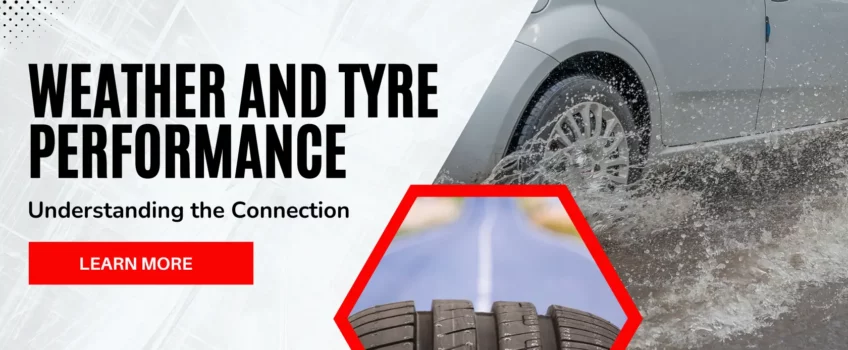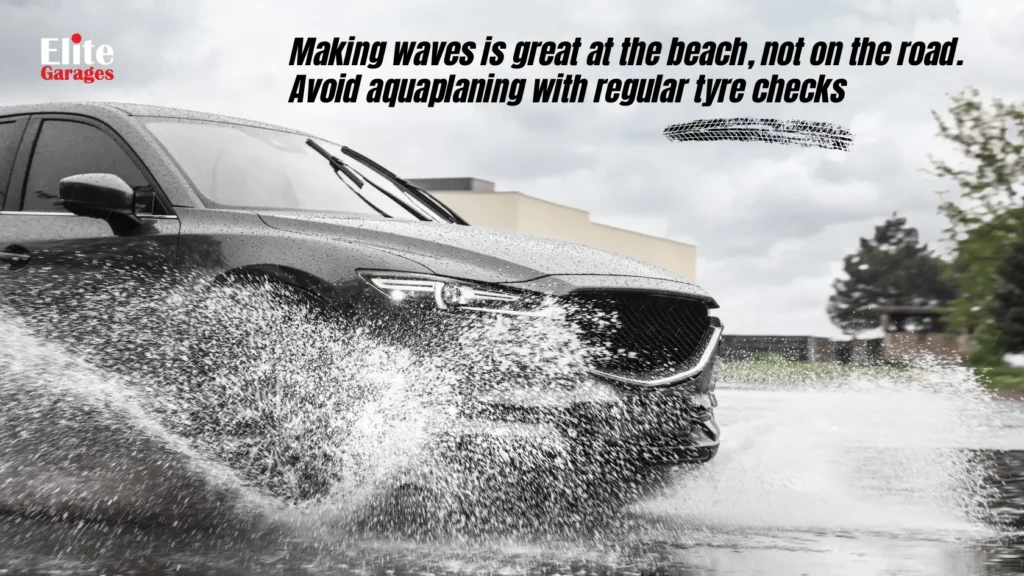
Tyre Performance and Weather Conditions: What’s The Connection?
The British weather is famously unpredictable, but there’s one thing you can count on: whether it’s pouring rain or sweltering sun, weather has a significant impact on your tyre performance. Understanding how weather affects tyre performance is essential for safe driving and prolonging the lifespan of your tyres. In this guide, we look at the different ways weather can impact your tyre performance and we also share some simply tyre maintenance tips.
The Rocky Relationship between Tyre Performance and Temperature
There are three major weather conditions which have a direct influence on tyre performance: heat, cold and wet.
Heat
Heat can cause tyres to expand due to the increase in air pressure inside them. This can reduce their grip on the road surface and increase braking distances. It is especially important to look out for this when travelling at high speeds as it increases the risk of a tyre blowout.
It is also important to ensure that you maintain the correct tyre pressure during hot weather. Low tyre pressure can cause damage such as tread separation or tyre bulging, which can put drivers and passengers at risk. Check your tyres regularly to ensure they are safe for use in all conditions. According to a general rule of thumb, a change of 10°C in ambient temperature typically leads to a 0.1 bar increase in tyre pressure, even when the vehicle has not been driven.
Cold
Cold weather can cause tyres to contract and become brittle, especially when temperatures drop below 7 degrees Celsius. This can significantly reduce tyre performance in terms of the car’s ability to grip the surface of the road, making driving more dangerous in icy or wet conditions.
It is also important to check your tyre pressure regularly during cold weather as it can affect your vehicle’s handling. Typically, tyre pressure tends to decrease by around 0.07 to 0.14 bars or 1 to 2 pounds per square inch (PSI) when the temperature drops by 10°C.
Wet
Driving in wet conditions can be especially dangerous as the tyres have less grip on the road surface. It is important to drive slowly and with caution when it’s raining or snowing, particularly on turns and bends. In addition, make sure your tyres are in good condition with sufficient tread depth as this will provide better grip on the road.
Overall, weather has an impact on tyre performance and it is important to be mindful of this regardless of where you are driving. You need to check your tyres regularly but especially before embarking on any long journeys. Keep an eye out for any changes in weather conditions and adjust your driving accordingly to ensure the safety of everyone on the road.
In case of rain, it is highly recommended to overinflate your tyres by approximately 5.8psi. This additional air pressure helps create a more secure contact patch with the wet road surface, reducing the chances of aquaplaning.

How Does Hot Weather Affect Tyre Pressure?
Here’s the fascinating science behind it: Air molecules have a tendency to expand when heated. So, as temperatures rise, the air trapped inside your tyres also expands, resulting in an increase in tyre pressure.
On the flip side, during cold spells, the pressure can actually decrease due to the contraction of air molecules. That’s why it’s crucial to regularly check your tyre pressure, especially during sudden temperature shifts, to ensure optimal performance and safety on the road.
By staying vigilant and mindful of these temperature-related changes, you can effectively maintain the health and longevity of your tyres.
How to Spot an Overheated Tyre
Heat can create a variety of issues with your tyres. Here are some signs to look out for that could indicate an overheated tyre:
- Abnormal noise coming from the wheel area
- If you feel your steering wheel vibrate, it could be a sign that a tyre is struggling
- Signs of wear and tear on the inside wall of the tyre
- A bubble or blister appearing on the sidewall
- Discolouration on the sidewalls
- Unusual, uneven wear patterns
- A distinct rubbery smell
What Problems Can Be Caused by Overinflated Tyres?
Most of us are aware that underinflated tyres can be problematic, but overinflating them can be just as hazardous. Overinflated tyres might not seem like a major concern, but they can compromise your vehicle’s performance and safety on the road and can lead to several issues, including the following:
- Reduced traction and grip on the road surface
- An increase in the risk of a tyre blowout
- A stiffer ride as more force is put onto the middle tread section
- Poor handling and braking
- Uneven wear on your tyres
- A harsher, less comfortable ride
Rain, Puddles, and Tyre Wear
Do Tyres Wear Out More in Rain?
Rain can be challenging for tyres, especially when water collects on the road, creating the potential for aquaplaning. This is when the tyre can’t dispel water fast enough, causing it to glide on a thin layer of water. While this doesn’t directly cause more tyre wear, it can be treacherous if tyres are already worn down, as they won’t be able to grip the road properly.
How Does a Tyre Pressure Monitoring System (TPMS) Help?
Your car’s TPMS is designed to alert you when tyre pressure drops below or rises above recommended levels. It’s a valuable safety feature, especially during seasonal changes. But remember, while TPMS is a handy tool, it doesn’t replace the need for regular manual checks.
Benefits Of Regular Tyre Maintenance
Regular maintenance and inspection of your tyres is essential to ensure that you are driving safely and not putting yourself at risk. It’s also important for prolonging the life of your tyres in all weather conditions, as well as maintaining fuel efficiency and reducing tyre wear.
It’s recommended that you check your tyre pressure monthly using a reliable tyre pressure gauge and make sure to follow the manufacturer’s recommendations, which you can find in your vehicle owner’s manual or inside the driver’s door panel.
To maintain optimal tyre performance irrespective of the weather, here are 4 things you should be doing:
- Check tyre pressure at least once a month and before long trips
- Rotate your tyres every 6,000 to 8,000 miles
- Avoid sudden, sharp turns and aggressive driving
- Inspect for signs of wear or damage regularly
Conclusion: Weather and Tyre Performance
Weather, as lovely or as unpredictable as it may be, plays a pivotal role in tyre performance. Being mindful of these effects, coupled with good tyre maintenance and driving habits, ensures safety on the roads and maximises tyre longevity. Curious to know more? Need a safety check?
Join us at Elite Garages for a free tyre safety check. You can also explore our online platform to learn more about tyres, MOTs, brake replacement, cambelt replacement or to book your service today.
Remember, don’t gamble with your safety by neglecting regular maintenance as it can help improve tyre performance. And, whatever you do, DO NOT buy part-worn tyres. Make the right call and choose new tyres from Elite Garages.
FAQS
Click the + to read any answer or visit our most FAQ page to review the most frequently asked questions across all our Elite Locations.
If you click on a ‘Category’ or ‘Tag’ link, the page will ‘refresh’ and reload the page showing the top of the page first, you’ll then just need to scroll down to the FAQ section to see the results for the Category or Tag you selected.
Rain itself doesn’t cause tyres to wear out faster. However, wet roads can highlight the reduced grip of worn tyres, leading to potential issues like aquaplaning. It’s essential to have good tread depth in rainy conditions to dispel water efficiently and maintain grip.
Yes, they do. Cold winter temperatures cause the air inside tyres to contract, leading to a drop in tyre pressure. This is why it’s especially important to regularly check your tyre pressure during the colder months to ensure safe driving conditions.
Absolutely. Weather conditions, from temperature fluctuations to precipitation, can influence tyre performance, wear rate, and overall safety. For instance, hot weather can cause tyres to overheat and expand, while cold conditions can make rubber compounds more rigid, affecting grip.
A general guideline is that for every 10°C change in ambient temperature, tyre pressure increases by 0.1 bar, even when the vehicle is not in use. Although this may seem insignificant, it’s important to consider that passenger vehicle tyres typically have only 30-35 PSI. A slight increase in air pressure can have a significant impact on the tyre, potentially leading to a blowout. Furthermore, over-inflation can affect braking performance and cause premature wear and tear.
About Us
Opening Times
Saturday : 8:30–4:00
Sunday : closed
More Information
Contact UsCustomer Information Pack
Check MOT Due Date
Free MOT reminder
Careers


